Back with another installment of the "Fabric Junkie"! Instead of focusing on various fibers and weaves, we're going to look just at jacquards. Remember, weave and fiber are two different properties of fabric, so when we talk about jacquard, we're referring only to weave. Jacquard is a term that everybody has heard, but it doesn't seem to be well understood. Simply put, a jacquard weave is one in which a raised pattern is woven into the fabric on the loom (as opposed to a fabric onto which a design is later stitched). In more technical terms, jacquards are woven on special looms (Jacquard looms, after their inventor, Joseph Marie Jacquard) that allow warp (lengthwise) threads to be individually and independently raised from the surface. The raised designs can be simple or pronounced, subtle or intricate.
While I'm not going into detail on the Jacquard loom and its history, anyone interested in fabrics may want to read up on it a bit. The Jacquard loom was invented in the early 1800s and utilized punched cards to separate and raise the warp threads, i.e., "program" the loom, much like early computers were programmed via punch cards. So, the Jacquard loom was a forerunner of our modern computer!
Some of the more well-known, easily recognizable jacquard weaves are brocade, which has a pronounced raised pattern, often in different colors and sometimes with metallic threads, on a contrasting background; damask, a subtle weave--generally tone-on-tone or a color on a coordinating shade--in which differences in the luster of the threads delineate the pattern; and tapestry, a more complex weave in which weft threads are woven over the warp threads to create the design. Matelasse', popular but not seen as often, has a quilted effect. Dobby weaves are fashioned on specialized looms to produce repeating, small geometric patterns, such as the birds-eye weave.
Jacquards are exceedingly versatile: they're found in almost every fiber--from silk to cotton, rayon to polyester. And they're used for a multitude of everyday items, from damask tablecloths to jacquard dress fabrics to heavy upholstery material. And in accessories, we see handbags, neckties, and scarves in all types of jacquard weaves.
Damask
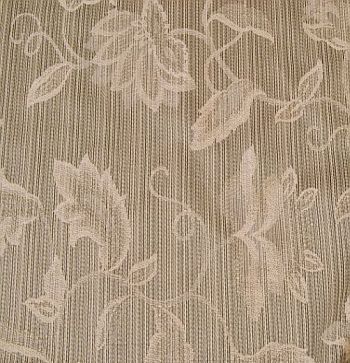
Brocade

And, here are a few items we have in our shops that demonstrate the "very versatile jacquard":
From Alley Cats Vintage, Fancy Gold and Black Brocade Two Piece Cocktail Party Outfit Vintage 1980s:
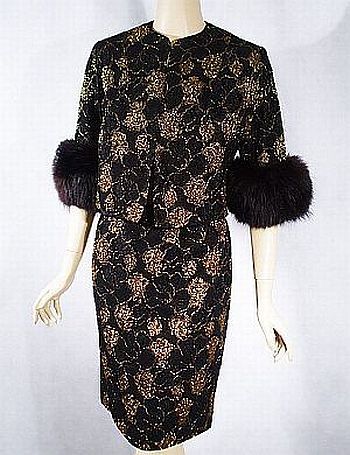
From CatseyeVintage, Vintage 80s Cerulean Blue Full Skirted Off the Shoulder VLV Cotton Sun Party Dress, Size XS to S:
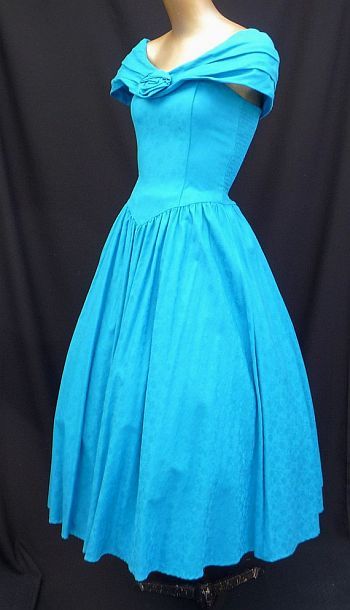
From Vintage Baubles Too, Vintage 60s Schoolgirl Dolly Mod Pencil Skirt and Vest Set, Small:
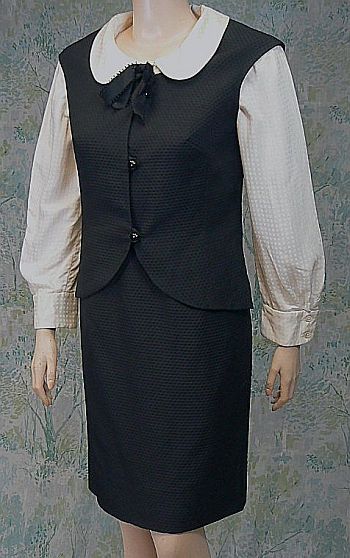
From CatseyeVintage, Vintage 50s LORRIE DEB Designer Couture Blue and Green Floral Silk Jacquard Full Skirted Party Dress, Bust 36, Size S - M:
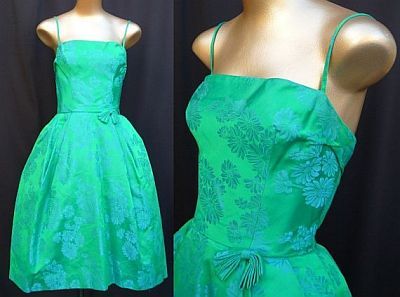
New this week at Vintage Baubles Too, this Vintage 50s/60s Mid Century Patterned Jacquard Neck Tie:
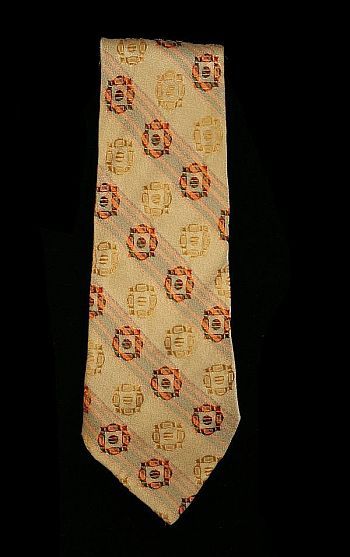
Welcome to another “Fabric Junkie” blog! Today I’ll tackle a topic that pushes my vintage buttons: fiber and weave. As both a seller and buyer of vintage apparel, I’m often dismayed when I ask a seller about the fiber from which an item is made, and I receive the online equivalent of, “Huh?” Especially if they have stated the weave in the description. To them, that’s equivalent and sufficient. To me, it’s only half the story. Fabric is a combination of fiber and weave, fiber being the raw material used to create it (e.g., wool, silk, rayon, polyester) and weave being the resulting look and texture once it is made into yardage. There is also the “how” of creating fabric (weaving, knitting, compressing, bonding, etc.), which affects weave, but that’s another can of worms for another day. Let's keep it simple today!
“So, why is this important?”, one might ask. While some buyers really don’t care what fiber a garment is made of, many do. Some can’t wear synthetics, some can’t wear certain natural fibers. For others, it’s a matter of preference. And, for both buyers and sellers, knowing the fiber can determine how to care for/clean/store the garment. This subject is so expansive and can be so complex, I don’t expect every seller to be a fabric expert! I don’t consider myself one, at that. But, since fiber-content labels are a relatively recent development in apparel manufacturing, all sellers need a basic understanding of fiber and weave, and how to recognize them. This information is important to buyers too, because knowing the fiber can help them get a sense of how the fabric will feel and drape (or not) on the body.
People often know weaves but don’t realize that several different fibers can be used to create the same weave. This seems to commonly occur with satin, taffeta, chiffon, jersey, velvet, gabardine, jacquard, seersucker, tweed, and a few others. Since this would be a book and not a blog if I addressed all of them, I’ll start with the first three:
Satin: Most folks know satin, that shiny, smooth-textured, “slippery” fabric from which many evening and wedding gowns, nicer lingerie, and some linings are made. It can be made from silk, rayon, and polyester, and, sometimes, acetate. Cotton satin is called “sateen.” De-lustered, or matte, satin is often done in silk and called “peau de soie.” It has a very subtle luster and is delightful! You can see the difference in sheen in these two dresses, one a traditional rayon satin, the other a peau de soie:
Rayon satin Fred Perlberg gown from Alley Cats Vintage:
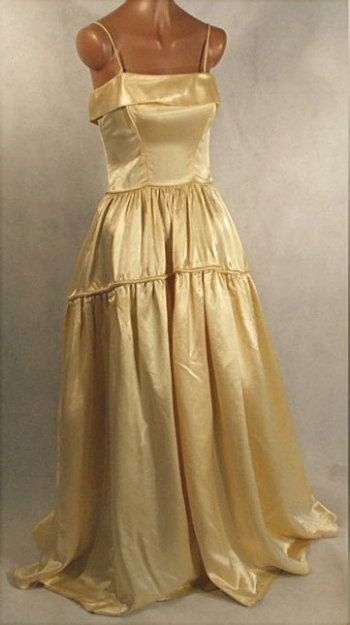
Pink peau de soie dress from Catseye Vintage:
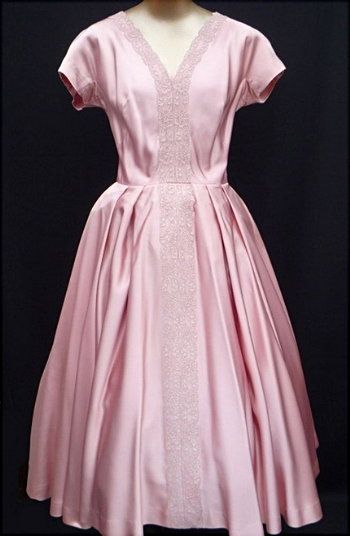
Taffeta: Also a smooth, finely woven fabric with a sheen to it, but is “crisp” and usually thinner than satin. It was very popular in the full-skirted party dresses of the 50s, often layered with tulle. Now commonly used in dress and coat linings. Though we usually see it in acetate or rayon, it used to be made mostly of silk. Nylon also can be woven into a taffeta finish—most notably the Barbizon “Tafredda” slips (when I got my first one, I was astounded that it was 100% nylon!).
Abbey Kent silk taffeta dress from Vintage Baubles:

Red rayon taffeta evening gown from Vintage Baubles Too:
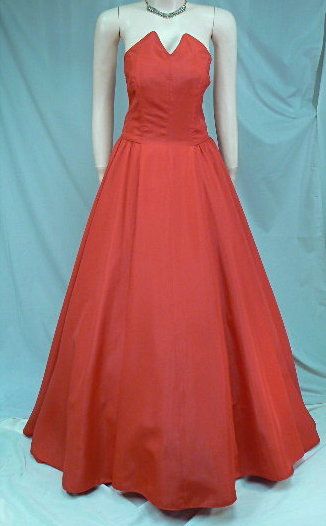
Chiffon: That sheer, thin, and airy fabric seen in party dresses, wedding gowns, etc. Vintage double-chiffon peignoir sets have been popular for years. Chiffon is often used for billowy sleeves, ruffled trim, and bodice insets. When used for a full garment, it’s often lined in taffeta. It can be made from silk, nylon, polyester, and rayon.
Print silk-chiffon dress sold by Vintage Baubles:
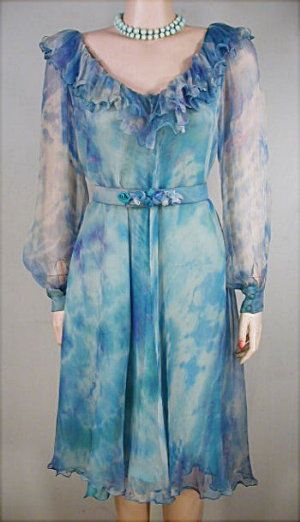
Nylon chiffon gown sold by Vintage Baubles:
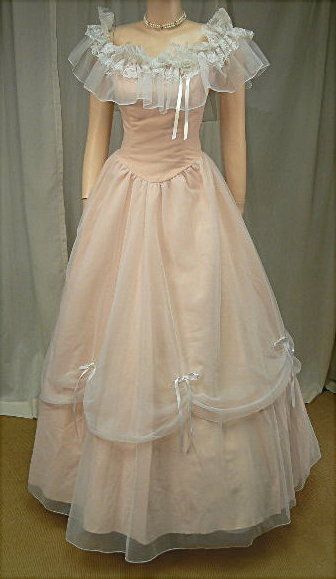
How to tell the difference? The best way is through handling as many different known fibers and weaves as you can. Note the content and weave of modern and vintage garments you already have--how they feel, how they drape, etc. Go to the fabric store, take a bolt of silk satin and one of polyester satin, and compare the feel. There is nothing like “hands-on” practice! Identifying fabrics will become much easier over time. But, no matter how well versed you are, sometimes you just can’t tell. I have three sewing books I use as reference; after sewing for 40 years and selling for 10, I still check them. Often. You should also learn how to do a burn test for fibers you can’t identify. This isn’t always possible, but it can be valuable when it is. Do a search for “fiber burn test,” and you’ll find charts, tips on methodology, etc. Bear in mind that any of the fabrics discussed today can consist of blends of fibers, and in that case, even a burn test may be inconclusive.
So, sometimes, if you’re a seller, you end up just not being sure. In that case, I generally state my best guess as to fiber. In online selling, where a buyer can’t handle an item, I think it’s critical to state, to the extent possible, the fiber and weave of a piece. I don’t know about you, but I wouldn’t spend hundreds of dollars to purchase a dress online without any idea of what fiber it is!
Be sure to keep an eye out for the next installment of "The Fabric Junkie"!

















